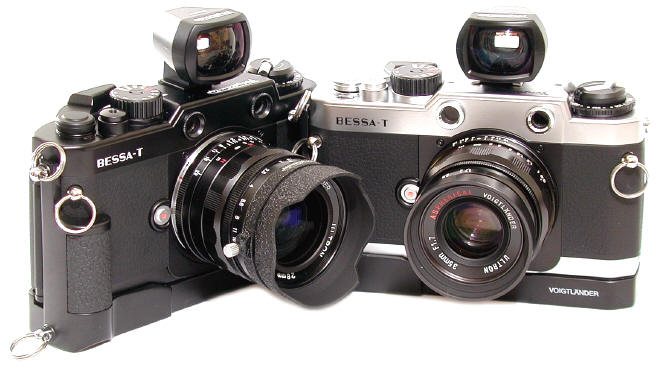
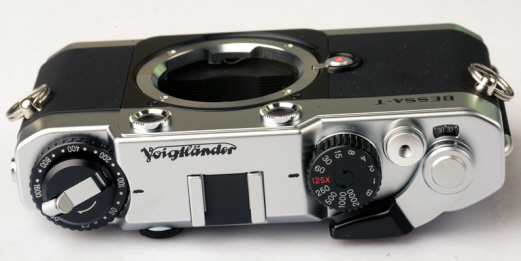
CameraQuest Home Shopping Cart Price List Camera Articles I Buy / Wants Repairs Books Adapters
Voigtlander Bessa T - Telemetro When Available Order Here


inexpensive M mount retro rangefinder for modern shooters
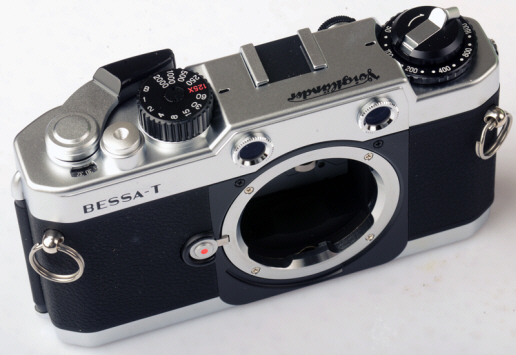
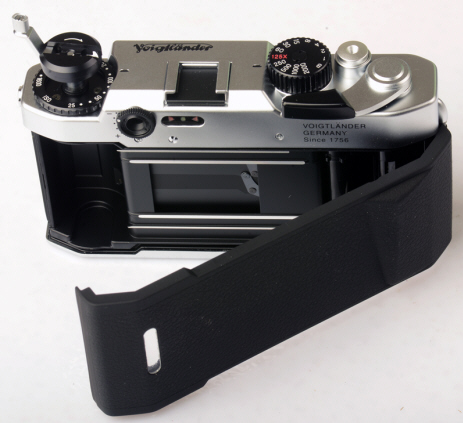
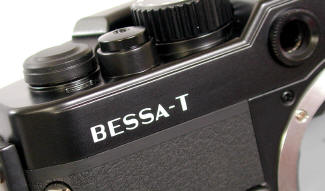
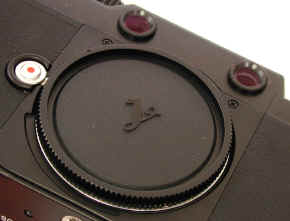
In March 2001 Cosina Voigtlander upset the rangefinder apple cart by introducing a VERY different sort of Leica M mount rangefinder. The T is so different many photogs take a look at the specs and are sure they won't like it ... until they see it for themselves. The Bessa T is Voigtlander's 1st M bayonet camera. Yes, the T mounts Leica M lenses, joining an elite group of Leica M's and the Konica Hexar RF with this legendary mount. The Bessa T is the least expensive M mount camera ever made, as well as one the most unusual M mount cameras. The Bessa T makes for an ideal low cost 2nd M body, or a low cost entry into the not so inexpensive Leica M system. See that thing mounted to the bottom of the camera ? That's a trigger winder -- a bottom mounted trigger wind advance for quick shooting. With practice, a trigger winder is faster than the regular lever advance at about 2-3 fps(frames per second). The Bessa T was discontinued 5/1/2004.
The top shot shows black and silver Bessa T's, mounting trigger winders and Voigtlander 28/1.9 and 35/1.7 lenses.
If you are new to rangefinders, don't be confused with the T mounting screw mount Voigtlander lenses. A standard adapter allows screw mount lenses to be used on the M bayonet mount --- easily and perfectly with full rangefinder coupling. If you are used to the venerable Leica M body cap, seeing a M cap with a "V" on it takes a bit of getting used to.
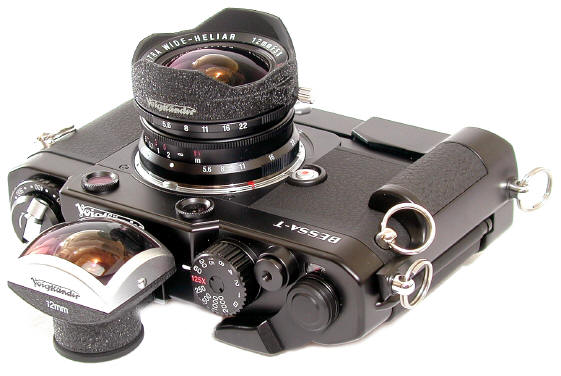
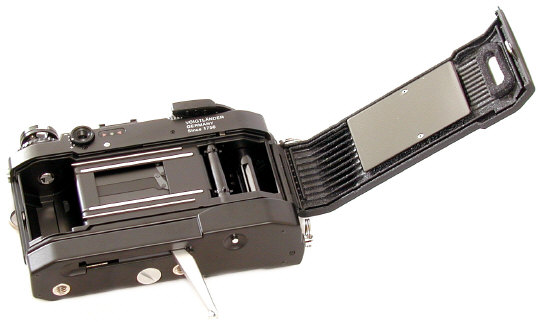
The T mounting the world's widest production rectilinear lens, the Voigtlander 12/5.6, and a trigger winder.
The Voigtlander Bessa T's design is unique amongst today's rangefinder cameras. The 1.5x rangefinder is built into the body while all view finders are interchanged separately. In other words, the body has no built in view finder. Strange huh ? Well, only until you get used to it. This system does offer some advantages. Separate viewfinders usually offer a better view of a particular frameline than combination frames built into camera bodies.
Notice the extra strap lugs on the trigger winder which allow the camera to be hung vertically -- like the old Leica M5 or CL. Personally, vertical carrying of the cameras was always a favorite of mine, but you will find more people who prefer horizontal. No right answer here, just choose the method you prefer.
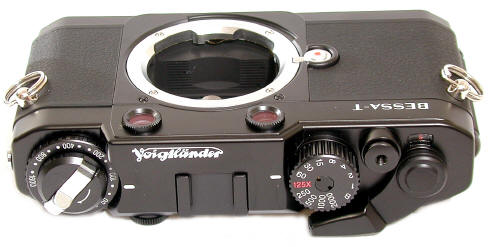
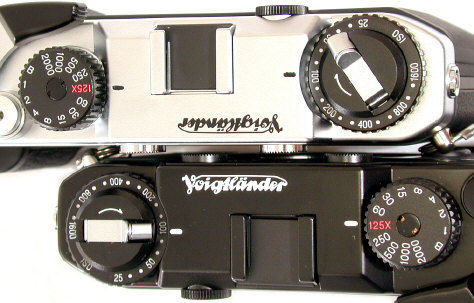
The rangefinder is especially interesting. With a 1.5x magnification, the Bessa T rangefinder has a longer effective baselength than Leica's fabled .72 M6 (53.7 Vs 49.86). The RF patch is large, ROUND, contrasty, and the two images have a slightly different color to make focusing that much easier. Eyeballing it, imagining a horizontal rectangle to 35mm format proportions, the view thru the RF is ABOUT 300mm. The Bessa T is the 1st non Leica made M mount capable of accurately focusing the 75/1.4 or 135/3.4 throughout the focusing range! Of course the separate viewfinder and rangefinder will take some getting used to. The separate viewfinder and rangefinder make for a slightly slower working camera -- you will be switching from rangefinder to the viewfinder as you shoot. Not everyone will like it, but some people will love it because of the larger viewfinder and rangefinder images. It's going to take a split second longer to focus with the rangefinder and switch to the viewfinder, but the 1.5x rangefinder can accurately focus any rangefinder coupled M or screw mount lens. The T won't be the best choice for moving action, but the big bright Voigtlander accessory finders generally offer as good, or better view than other rangefinders with built in finders. The separate viewfinder and rangefinder is a tradeoff in the battle to give photogs more bang for the buck. Is the trade off worth it? I think so. Where else are you going to get an inexpensive new M mount camera capable of accurately focusing the 50/1 Noctilux ?
Rangefinder Base length of 53.7mm: This translates to an effective rangefinder base length of 53.7mm for the 1.5x magnification Bessa T. In other words, the T's rangefinder EBL is 108% longer than standard .72 Leica M finder with an EBL of 49.32.
The top plate layout is simple and effective. The silver Bessa T's are all of the handsome "Panda" variety with a mixture of silver and black fittings. Panda you ask ? When Leica ran out of chrome M6 fittings for the chrome M6 a few years back, they started shipping them with black dials and advances. These became known as the "Panda" M6 in the US, in part due to much real Panda press coverage at the time. Some Leica collectors are foolish enough to pay extra for them, to the amusement and delight of saner Leica shooters. While I sell silver Bessa T's at the normal rate, I will bow to market demand and sell "Panda" Bessa T's at only a 50% premium with a special Arizona Desert ocean front real estate package. Did you notice there are NO flash contacts in the T's accessory shoe? That's because the only flash connection is via the side mounted PC connection.
Most specs are identical to the Bessa R or L: Vertically traveling Mechanical Copal Shutter with outer light shield, 1-1/2000 speed range, 1/125th flash sync, Silicon center weighted TTL meter, no TTL flash, same body casting, same easy film loading.
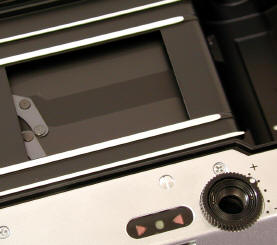
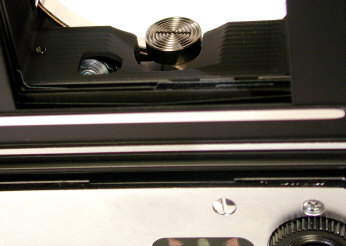
The Bessa T's meter readout is on the back edge of the top plate, near the adjustable diopter rangefinder eyepiece. This is a better location than in the rangefinder, where a LED readout would be very distracting. The silicon metering cell is in the top of the film chamber, angled downward towards the gray outer shutter.
FLASH: The Voigtlander Bessa T (and Bessa L) are a bit of a problem with flash, since the finder occupies the same accessory shoe that would normally hold the flash. I think the best flash solution are professional "potato masher" handle flash units with a built in flash sensor. For the Bessa T or Bessa L, most photogs mount their flash on a side flash bracket. Unfortunately, the bulk of the small flash with a flash bracket is about the same as the larger, more powerful potato masher flashes. To me, it just makes more sense to use the larger flashes with the Bessa T and Bessa L, since you are going to be stuck with the extra weight and bulk of a flash bracket anyway, and get the extra power of the larger flash. My personal favorite "potato masher" flashes with self contained battery packs and a built in sensor include the Ascor 1600, Rollei 36RE, the various Metz 45 series, and the Sunpak 522 or 544.
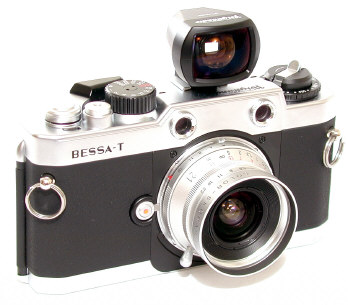
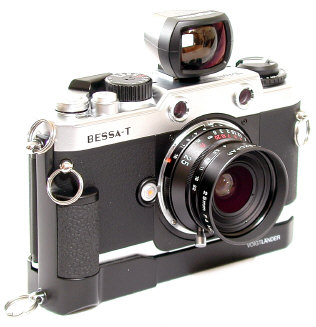
The T with the 21/4 (top) and 25/4 (bottom)
Improvements over the Bessa R:
M bayonet mount capable to taking M lenses, or screw mount lenses with adapter
Optional trigger winder advance
Apparently stronger top plate compared to the Bessa R or L. All three use polycarbonate top and bottom plates with a cast metal inner body.
Stronger reinforced back door
Ratcheted film advance
Slightly Quieter -- at least to my ears
WILL take the Abrahamsson Classic Soft Release, like the Bessa L but unlike the Bessa R
The Bessa T was an interesting evolutionary dead end for Voigtlander. All the later M mount Bessas included built in rangefinder/viewfinders (R2A,R2M,R3A,R3M,R4A,R4M,R2S,R2C). Yet the Bessa T has a longer rangefinder baselength than all of them and the only Bessa rangefinder with a built in diopter adjustment. The T has an endearing simplicity to it that is quite nice.
Special edition Bessa T's were made in 4 different colors with the special 50/3.5 Heliar lens, CLICK HERE FOR INFO.
Differences between the Bessa T and Bessa R
M bayonet mount instead of Screw Mount
No built in view finder: 35.8mm baselength, 1.5x magnification rangefinder with an effective Rangefinder baselength of 53.7 mm -- LONGER than a .72 M6, long enough to accurately focus any Leica M lens. The high magnification rangefinder / separate viewfinder concept was introduced by Leica in their classic 1933 Leica III and continued in use till the IIIg. It was developed further along the lines used by the Bessa T with the 1946 Nikon One, by mounting the separate 35-135 finder with high magnification RF cap attachment. See Bessa T or IIIF page.
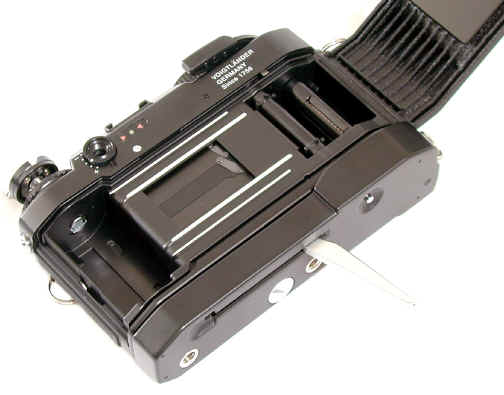
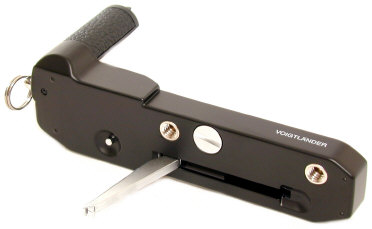
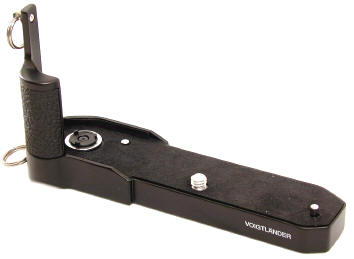
Factory trigger winder capability. While the bodies are made in either silver or black, trigger winders are made in black only. The metal bodied trigger winder is an especially nice feature which experienced shooters are likely to appreciate, but newbies may dismiss as not needed. Today the T rapid winder is the ONLY factory trigger winder available for interchangeable lens RF cameras. It sells for less than half of what the admittedly better made Abrahamsson Rapidwinder for Leica M's sells for, while the Rapidwinder sells for less than Leica could produce it for (a real bargain in its own right). With practice you can shoot about 2 to 3 frames per second with it, or faster than you can with a top mounted lever advance. Also, if you happen to be "left eyed," the trigger winder keeps you from being jabbed in the eye by the advance lever. It's a bargain, do yourself a favor. If you buy a T, buy the trigger winder too, and learn how to use it. The trigger winder also features a built in side grip with 3 lug carrying straps which allow vertical carrying of the camera, and a tripod socket. You can load the Bessa T without removing the trigger winder, whether or not it is tripod mounted.
The trigger winder thankfully attaches WITHOUT having to remove any bottom plate covers, which almost always get lost. Yes, the Rapidwinder body is metal.
LED meter read out moved to the back of the top plate, like the Bessa L. EV 1-19, ASA 25 to 1600
Built in diopter adjustment for Rangefinder eyepiece. This seems like a small thing, but it is actually a BIG deal. NO Leica M rangefinder has ever every left the factory with an adjustable eyepiece. The T is the ONLY interchangeable lens RF with this feature. Frankly, I am not sure if the Contax G1/G2 has this feature or not, but to me the G1/G2 are autofocus interchangeable lens Point & Shoots, not rangefinders.
So what do we have here?
A low priced M camera that can focus even fast telephoto Leica M or Screw mount lenses accurately, even the 50/1, the 75/1.4, or the 135/3.4. The Bessa T is a great low cost entry into the M system, or a great low cost 2nd M body
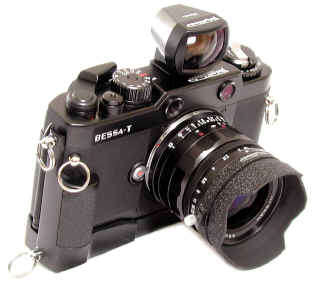
The T with the Voigtlander 28/1.9 and 35/1.7
What does it mean ?
Voigtlander is alone in the entry level M camera market, with the lowest cost M camera and lowest cost quality Leica compatible lens lineup -- a market Leica has ignored since it discontinued the Leica CL a quarter of a century ago. With incredible creativity and an amazing ability to turn out new lenses and cameras quickly, a new star is rising in the rangefinder world.
What the Bessa T isn't
If you were hoping for a new advanced M camera to go head to head with the M6, this isn't it, nor was it designed to be. Instead the Bessa T aims to open up an entire new territory to the M photographer, the LOW COST ENTRY M MARKET, succeeding admirably.
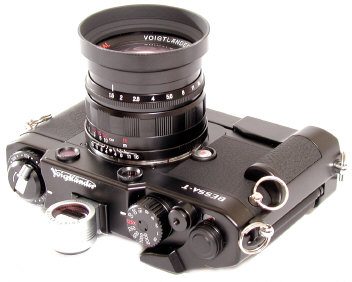
The Bessa T with trigger winder and mounting the Voigtlander 75/2.5 and 50/1.5 screw mount lenses via M adapters.
Due primarily to the possibility of hitting the Bessa T's outer shutter, these lenses are NOT recommended:
Leica Hologon 15mm F8
Leica Super Angulon 21mm F3.4
Leica Super Angulon 21mm F4
Leica Elmarit 28mm F2.8 (first model)
Leica Summicron 35mm F2 (7 elements type, serial #2974251 or later)
* 6 or 8 elements type and aspherical type OK
Leica Summilux 35mm F1.4
* Aspherical type can be used
Leica Dual range Summicron 50mm F2 -- it won't mount properly on the bodyThe collapsible 50/2 Summicron fits fine on the T, and is able to collapse fully. The collapsible 50/2.8 Elmar will collapse, but not fully -- so don't push it that extra 3/32" or so. There are many collapsible lenses, and I have not tried all of them on the T, so be careful when collapsing a lens least you damage the shutter or meter.
The collapsible Voigtlander 50/2 Heliar, introduced at Photokina 2004, CAN be safely collapsed into ALL Cosina Voigtlander Bessas.
I would also be very careful mounting any wide angle with deeply set rear elements, such as the 20, 28, or 35mm Russian lenses in Leica screw mount.
Bessa T with Visoflex
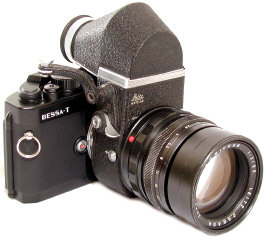
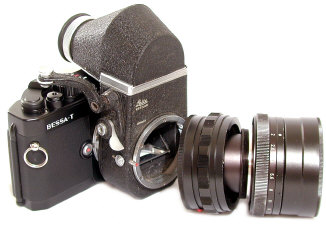
Surprisingly, the T will mount either the Visoflex II, IIa or III WITHOUT any modification of the release arm. All you have to do is use the Abrahamsson Soft Release to take up the difference in clearance between the arm and the Bessa T's shutter release. What's a Visoflex ? It's a Leica made reflex housing that was designed to turn Leica M rangefinders into an SLR. While extending the M's versatility, it is not as convenient as a regular SLR. Viso 3's were only made in M mount. If you have a Viso II or IIa in screw mount, just add the screw mount to bayonet mount adapter to mount it on the Bessa T.
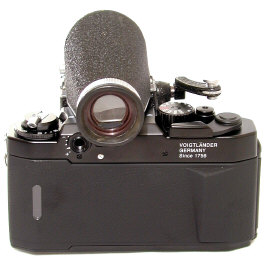
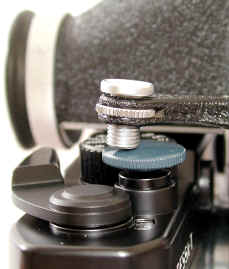
Join the Cosina Voigtlander User Mailing List
Hmm. So who would buy a such a very different kind of retro rangefinder like the Bessa T?
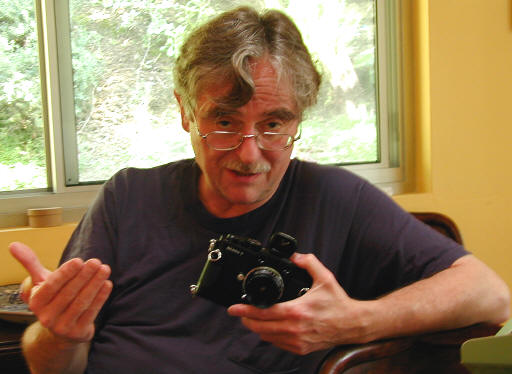
Well, at least one famous internationally award winning photo journalist named Bill Pierce.
(digital shot taken with Nikon Coolpix 950)
The Voigtlander Bessa T has a special place in Leica M mount camera history.
First of all, the Bessa T is a unique camera design utilizing a built in rangefinder without a built in viewfinder. It is the ONLY Leica M mount camera with a built in diopter adjustment for the rangefinder. It was the ONLY Leica M mount camera with a meter readout visible from the top of the camera, making it ideal for low angle and Visoflex applications (until the much more expensive Zeiss Ikon SW in 2006). It is the 1st mechanical shutter Leica M mount camera not built in cooperation with Leica. It is the least expensive Leica M mount camera ever made. It is the first Leica M mount camera made by Cosina Voigtlander. All in all, not a bad list of achievements for Mr. K's 1st M camera!
Prices Voigtlander System Bessa Chart Bessa R2A/R3A Bessa R2 Bessa T Heliar 101 101 PICS Bessa T intro Bessa T T or IIIf? Bessa R Lenses 35/1.2 21/25 Shade
Accessories VC Meter II MiniSoftRelease Bessa R2S & R2C SC Lens Intro SC Lenses SL Lenses SL 12&15 Lenses Prominent 50mm Lens Adapter
CameraQuest Home Shopping Cart Price List Camera Articles I Buy / Wants Repairs Books Adapters
Revised: September 11, 2017 . Copyright � 2001--2014 Stephen Gandy. All rights reserved. This means you may NOT copy and re-use the text or the pictures in ANY other internet or printed publication of ANY kind. Information in this document is subject to change without notice. Other products and companies referred to herein are trademarks or registered trademarks of their respective companies or mark holders.